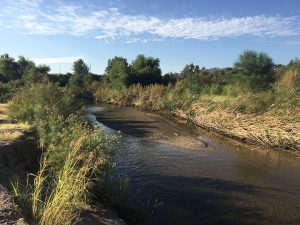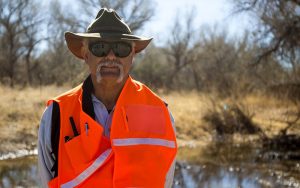- Slug: BC-CNS-Santa Cruz Sewage. 495 words.
- Photos and captions below.
- Soundcloud here.
By NANCY MONTOYA
Arizona Public Media
NOGALES – Some residents of Santa Cruz County are warning that the pipeline carrying raw sewage from Mexico into the United States could rupture as it did during last year’s monsoon, spewing millions of gallons of waste into the Nogales Wash over seven days.
The wash is a main tributary of the Santa Cruz River, which begins near Patagonia and flows south into Mexico before making a U-turn back into Arizona, where it finally reaches Tucson, 70 miles north of the border. The 8.5-mile pipeline can transport 14 million gallons a day from Nogales, Sonora, and Nogales, Arizona, to a treatment plant in Rio Rico. Treated water then is released into the Santa Cruz to support riparian areas and recharge the water table.
Ben Lomeli, a hydrologist with more than 40 years of experience and a longtime resident of Santa Cruz County, said the river again is in jeopardy because the pipeline only was patched last year and could break again under heavy rains. Lomeli said he has traversed by foot most of the pipeline and has spotted some leaks.
“It doesn’t rupture in places where it runs under the streets,” said Lomeli, who worked for the Bureau of Reclamation for two decades and now is a part-time consultant. “It doesn’t rupture in places where it is away from the wash. It ruptures where it is co-located either underneath the wash or right next to the Nogales Wash.”
Lomeli said he and others who study and care about Arizona waterways are sounding the alarm on the 50-year-old sewage pipeline – officially known as the International Outfall Interceptor – as the single biggest threat to the Santa Cruz River.
Jonathan Horst, the director of conservation and research for the Tucson Audubon Society, also warns of trouble for the river if another sewage spill occurs.
He said the Santa Cruz is vital to preserving riparian areas rich with native vegetation and wildlife, including migratory and non-migratory birds.
“Over 90 percent of the riparian areas of have been lost in Arizona and New Mexico,” Horst said. Birders come from all over the world to southern Arizona, to see all these birds that are more common in southern Arizona than in anywhere else in the U.S.”
The Santa Cruz and the riparian areas it supports, Horst and Lomeli said, are longtime, sustainable economic drivers for the region.
No one disagrees the pipeline needs to be replaced and that Arizona needs that treated effluent for the Santa Cruz River. But the cost is $80 million. Santa Cruz County and Nogales officials say they don’t have that kind of money and that Arizona should shoulder much of the cost.
And Arizona? The state’s Department of Environmental Quality is suing the federal government, saying a treaty between the U.S. and Mexico 50 years ago created the pipeline, so it’s a federal problem to solve and pay for.
Meanwhile, there’s more than a month left to the monsoon season.
Follow us on Twitter.
For more stories from Cronkite News, visit cronkitenews.azpbs.org.
^_=

